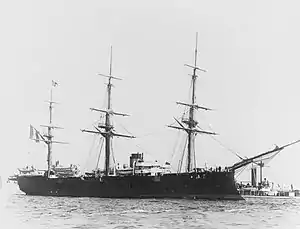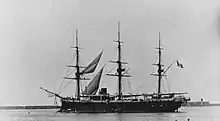French cruiser Aréthuse
Aréthuse was an unprotected cruiser built for the French Navy. The ship was laid down in 1879 and completed in 1885. Intended to serve as a long-range commerce raider, the ship was fitted with a sailing rig to supplement its steam engine on long voyages, and she carried an armament of four 165 mm (6.5 in) and twenty-two 140 mm (5.5 in) guns. She was among the final French unprotected cruisers, thereafter being replaced by more durable protected cruisers.
 Aréthuse at the World's Columbian Exposition naval review in April 1893 | |
| Class overview | |
|---|---|
| Preceded by: | Naïade |
| Succeeded by: | Dubourdieu |
| History | |
| Name: | Aréthuse |
| Builder: | Arsenal de Toulon |
| Laid down: | February 1879 |
| Launched: | 1882 |
| Commissioned: | July 1885 |
| Fate: | Broken up, 1901 |
| General characteristics | |
| Displacement: | 3,487 long tons (3,543 t) |
| Length: | 74.37 m (244 ft) loa |
| Beam: | 14.25 m (46 ft 9 in) |
| Draft: | 6.91 m (22 ft 8 in) |
| Installed power: |
|
| Propulsion: |
|
| Sail plan: | Full ship rig |
| Speed: | 15.5 knots (28.7 km/h; 17.8 mph) |
| Complement: | 467 |
| Armament: |
|
The ship served with the main fleet in the Mediterranean Sea in 1886 before being assigned to patrol duty with the South Atlantic Squadron, serving as the unit's flagship. Aréthuse had been transferred to the North Atlantic Squadron by 1890, and was extensively modernized in 1891–1892. Another stint with the North Atlantic Squadron followed from 1893 to 1895, and in 1899, she was reduced to a hulk. Aréthuse was briefly used as the headquarters for the coastal defense unit based in Landévennec, but was broken up in 1901.
Design
In 1878, the French Navy embarked on a program of cruiser construction authorized by the Conseil des Travaux (Council of Works) for a strategy aimed at attacking British merchant shipping in the event of war. The program called for ships of around 3,000 long tons (3,048 t) with a speed of 16 knots (30 km/h; 18 mph). Four vessels were ordered, including Aréthuse; the vessels were dated designs more similar to the first screw frigates that had been built in the 1850s than the latest protected cruisers being designed abroad. Aréthuse and the other three vessels were the final generation of unprotected cruisers built in France, that type thereafter being replaced by protected cruisers beginning with Sfax in the early 1880s.[1]
Characteristics
Aréthuse was 74.37 m (244 ft) long overall, with a beam of 14.25 m (46 ft 9 in) and a draft of 6.91 m (22 ft 8 in). She displaced 3,487 long tons (3,543 t). Her hull was constructed with wood; she had a clipper bow and an overhanging stern. She had a raised forecastle and sterncastle. The ship had no armor protection. Her crew varied over the course of her career, ranging from 467 to 474 officers and enlisted men.[2][3]
The ship was propelled by a single horizontal compound steam engine that drove a screw propeller. Steam was provided by eight coal-burning fire-tube boilers that were ducted into a single funnel located amidships. Coal storage amounted to 500 long tons (510 t). The power plant produced 3,200 indicated horsepower (2,400 kW) for a top speed of 15.5 knots (28.7 km/h; 17.8 mph). To supplement her steam engines, she was fitted with a three-masted full ship rig.[2]
The ship was armed with a main battery of four 165 mm (6.5 in) M1881 28-caliber guns that were placed in sponsons on the upper deck, two per side. These were supported by a secondary battery of twenty-two 140 mm (5.5 in) M1881 30-caliber guns, twenty of which were paced in a central gun battery on the main deck, ten per broadside. The remaining two guns were on the fore- and sterncastle for use as chase guns. For close-range defense against torpedo boats, she carried a tertiary battery of eight 1-pounder Hotchkiss revolver cannon in single pivot mounts.[2]
Modifications
In 1891–1892, Aréthuse was modernized extensively, receiving new boilers and an overhaul of her engine. The improved propulsion system allowed the ship to reach a speed of 17 knots (31 km/h; 20 mph) from 4,000 indicated horsepower (3,000 kW) during speed tests. Six of the secondary guns were removed and the remaining sixteen guns were kept in the broadside battery. The ship also had four more 1-pounder revolvers added.[2]
Service history

Aréthuse was laid down at the Arsenal de Toulon in February 1879 and was launched on 14 September 1882. The ship was completed in July 1885.[2][3] The following year, she was placed in reserve.[4] Later that year, Aréthuse was activated to take part in the annual large-scale fleet maneuvers with the Mediterranean Squadron that year, which were held off Toulon from 10 to 17 May. The exercises were used to test the effectiveness of torpedo boats in defending the coastline from a squadron of ironclads, whether cruisers and torpedo boats could break through a blockade of ironclads, and whether a flotilla of torpedo boats could intercept ironclads at sea. Aréthuse was assigned to the defending squadron, along with the coastal defense ship Fulminant, the cruisers Dupetit-Thouars and Desaix, and twenty torpedo boats. The exercises demonstrated the limited usefulness of the small French torpedo boats, and late in the maneuvers, Aréthuse was judged to have been "hit" by a torpedo from a friendly torpedo boat.[5] In 1887, Aréthuse was transferred to the South Atlantic Squadron, where she served as its flagship.[3]
By 1890, the ship had been assigned to the North Atlantic Squadron, along with the unprotected cruisers Roland, Kerguelen, and Sané and the sloop Bisson.[6] Aréthuse was decommissioned to be modernized in 1891 and conducted sea trials in January 1892.[2] The following year, she returned to the North Atlantic squadron, which included the unprotected cruisers Magon and Segond and the sloop Hussard.[7] She remained assigned to the station in 1894, and in September, she was sent to Rio de Janeiro, Brazil, in response to the outbreak of the Revolta da Armada (Revolt of the Fleet). Aréthuse was joined by several British, German, and Italian vessels, all of which were sent to protect European interests in the area. The French, British, German, and Italian commanders, having threatened to bombard the city, negotiated with the Brazilian naval commander and President Floriano Peixoto and secured an arrangement where neither side would fire on the other without having been shot at first.[8]
Aréthuse was recalled home by 1895.[9] The ship was converted into a hulk in 1899. She was used as the headquarters for the Defense Mobile, the local coastal defense force, based in Landévennec. She served in that capacity for just two years before being broken up in 1901.[3]
Notes
- Ropp, pp. 108–109.
- Gardiner, p. 319.
- Fisher, p. 235.
- Brassey 1886, p. 486.
- Brassey 1888, pp. 208–222.
- Brassey 1890, p. 67.
- Brassey 1893, p. 71.
- Clowes, p. 195.
- Brassey 1895, p. 53.
References
- Brassey, Thomas, ed. (1886). "List of French Ships in Commission". The Naval Annual. Portsmouth: J. Griffin & Co.: 486–490. OCLC 496786828.
- Brassey, Thomas, ed. (1888). "French Naval Manoeuvres, 1886". The Naval Annual. Portsmouth: J. Griffin & Co.: 207–224. OCLC 496786828.
- Brassey, Thomas, ed. (1890). "Chapter V: The Foreign Stations". The Naval Annual. Portsmouth: J. Griffin & Co.: 64–68. OCLC 496786828.
- Brassey, Thomas A. (1893). "Chapter IV: Relative Strength". The Naval Annual. Portsmouth: J. Griffin & Co.: 66–73. OCLC 496786828.
- Brassey, Thomas A. (1895). "Chapter III: Relative Strength". The Naval Annual. Portsmouth: J. Griffin & Co.: 49–59. OCLC 496786828.
- Clowes, W. Laird (1894). Brassey, Thomas A. (ed.). "Chapter XI: The Naval Revolt in Brazil". The Naval Annual. Portsmouth: J. Griffin & Co.: 191–206. OCLC 496786828.
- Fisher, Edward C., ed. (1969). "157/67 French Protected Cruiser Arethuse". Warship International. Toledo: International Naval Research Organization. VI (3): 235. ISSN 0043-0374.
- Gardiner, Robert, ed. (1979). Conway's All the World's Fighting Ships 1860–1905. London: Conway Maritime Press. ISBN 978-0-85177-133-5.
- Ropp, Theodore (1987). Roberts, Stephen S. (ed.). The Development of a Modern Navy: French Naval Policy, 1871–1904. Annapolis: Naval Institute Press. ISBN 978-0-87021-141-6.